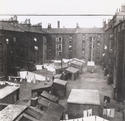 Glasgow's image as a Victorian city owes much to the grey, beige and reddish sandstone tenemented streets erected mostly between 1850 and 1900. Governed by the Glasgow Police Act, these four-storied blocks, never taller than the width of the street, were built in city blocks with short gardens, drying greens and outside lavatories or ash pits at the centre.
Glasgow's image as a Victorian city owes much to the grey, beige and reddish sandstone tenemented streets erected mostly between 1850 and 1900. Governed by the Glasgow Police Act, these four-storied blocks, never taller than the width of the street, were built in city blocks with short gardens, drying greens and outside lavatories or ash pits at the centre.
 Tenement construction increased 600 per cent between 1862-72 and 21,000 tenement flats were built between 1872 and 1876. Each floor of the 1875 model working class tenement comprised a single room flat sandwiched by two two-room flats. Few had lavatories. The standard middle class flat was three-roomed; but those in the Novar Drive area were much larger, and those in Terregles Avenue, Pollokshields (1895), ran to a parlour, dining and drawing rooms, two bedrooms, a bathroom closet, pantry, kitchen and a servant's bedroom.
Tenement construction increased 600 per cent between 1862-72 and 21,000 tenement flats were built between 1872 and 1876. Each floor of the 1875 model working class tenement comprised a single room flat sandwiched by two two-room flats. Few had lavatories. The standard middle class flat was three-roomed; but those in the Novar Drive area were much larger, and those in Terregles Avenue, Pollokshields (1895), ran to a parlour, dining and drawing rooms, two bedrooms, a bathroom closet, pantry, kitchen and a servant's bedroom.
 The most coherent tenement districts lie around West Princes Street, or the streets between Partickhill and Byres Road. Only the poorest streets, such as West End Park Street, lacked elaboration. Most tenement flats had a bay window providing the street with a rhythm of bay window towers. Grander tenements had external carving, decoration, bay windows, close doors; or stained or painted glass in the stair windows, iron balustrades, or halls lined with decorative tiles (a "wally" close). A number were overtly classical, designed by "Greek" Thomson, or by Alexander Taylor at Clarendon Place (1829). Most dramatic was the sweeping curve of the golden stone-fronted Minerva Street leading into St Vincent Crescent (1849–1858) by Alexander Kirkland. Machine-cut Dumfriesshire red stone at the end of the century brought tenements with rippling bay windows, tall decorated chimney-stacks and many other details of the Glasgow style.
The most coherent tenement districts lie around West Princes Street, or the streets between Partickhill and Byres Road. Only the poorest streets, such as West End Park Street, lacked elaboration. Most tenement flats had a bay window providing the street with a rhythm of bay window towers. Grander tenements had external carving, decoration, bay windows, close doors; or stained or painted glass in the stair windows, iron balustrades, or halls lined with decorative tiles (a "wally" close). A number were overtly classical, designed by "Greek" Thomson, or by Alexander Taylor at Clarendon Place (1829). Most dramatic was the sweeping curve of the golden stone-fronted Minerva Street leading into St Vincent Crescent (1849–1858) by Alexander Kirkland. Machine-cut Dumfriesshire red stone at the end of the century brought tenements with rippling bay windows, tall decorated chimney-stacks and many other details of the Glasgow style.
 Tenements were class-neutral ranging from the tiny, single room flat to an enormous elite apartment. They gave Glasgow physical homogeneity and provided the semblance of having a more integrated community than those cities whose wealthy had fled to detached houses in the suburbs.
Tenements were class-neutral ranging from the tiny, single room flat to an enormous elite apartment. They gave Glasgow physical homogeneity and provided the semblance of having a more integrated community than those cities whose wealthy had fled to detached houses in the suburbs.